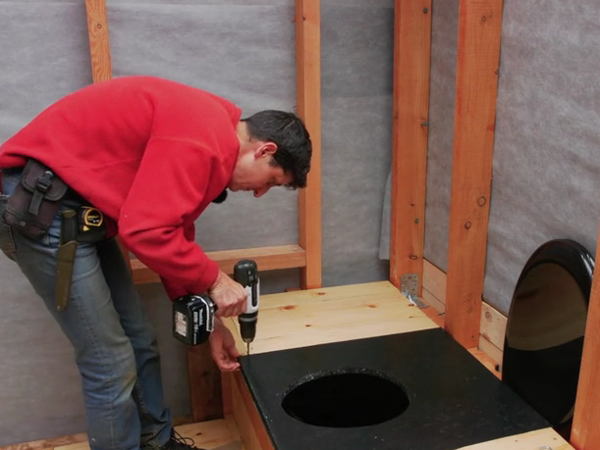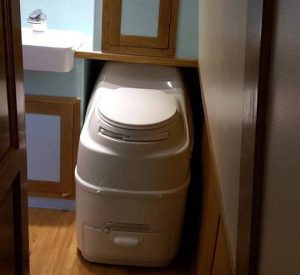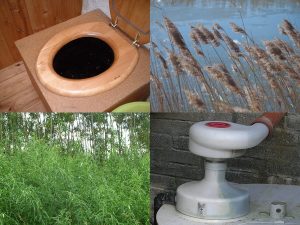We’ve produced an online course on building, using and maintaining a range of different compost toilets. You can purchase the new compost toilets online course here.
If aliens were to land on this planet, and we were to try to explain to them the way we live on earth, amongst all the crazy things that we as a species get up to, perhaps one of the most difficult to explain would be the process of expending vast amounts of time, energy and money producing and delivering pure, precious drinking water to all homes (in the West anyway), only for people to crap in it, thereby destroying two precious resources at the same time (pure water and fertiliser), and causing disposal and pollution problems in the process.
Or as Joe Jenkins, of Humanure Handbook fame puts it: “The world is divided into two categories of people: those who shit in drinking water and those who don’t.”
Crazy as this is, of all the Lowimpact.org topics, this one causes the most mirth. When we attend events, most people look at our information boards and make interested noises about solar hot water, biodiesel or straw-bale building, but chuckle when they come to compost loos and say, ‘no way’, or ‘I can just see my mother using one of those when she comes to visit!’
We want to help people build and install compost toilets that are comfortable, preferably indoors, odour-free, and generally ‘mother-friendly’ (i.e. wouldn’t scare your mother too much). My mother wouldn’t be over the moon having to use using a compost loo, let alone peak-knocking (see ‘use and maintenance’) or emptying one. But then again she wouldn’t be reading this either. Some people are up for it and others aren’t. The fact that you are reading this probably means that you are.
However, there must be a lot of people out there taking it seriously, because it’s one of our most popular topics. Our book on compost loos is selling well, and so we decided that we’d put together an online course, covering a range of different kinds of toilets, with a combination of text and videos explaining how to install and maintain them.
A well-designed compost toilet is the pinnacle of sustainable sewage treatment, especially when combined with a waterless urinal (preferably draining onto a straw-bale to produce compost) and a reed bed and pond to cope with liquid wastes and to provide water for a garden.

We got together with Cordelia Rowlatt of Vallis Veg – they have a range of outdoor compost toilets on their smallholding, and they’ve built a compost loo for their home, in a specially-built extension. Piotr Karter of Studio Nima went along to produce over 3 hours of videos of Vallis Veg toilets, plus lots of text produced by Cordelia to accompany them – then we added the entire contents of our book, which explains how to self-build a compost loo, based on a two-chamber, indoor toilet built at Redfield Community in Buckinghamshire. It also covers the benefits, the risk of pathogens, the decomposition process and the maintenance and care of an indoor compost loo.
We’ve priced it at £45 – much cheaper than other online courses of similar quality and quantity of content. All income from the course will be use to make more online courses, rather than lining anyone’s pocket. We’d just like more compost loos to be in existence.
There is a big opportunity for compost toilets in new-build housing. They can be quite difficult to retro-fit into existing houses, and they won’t get used much if outdoors. We hope that one day, all new houses, instead of having a conventional sewer connection, will have a solid, reliable purpose-built or proprietary compost toilet (like a Clivus Multrum for example) as standard, as well as rainwater harvesting, greywater recycling (not to mention solar hot water, heat pump, photovoltaics, wind turbine – I could go on and on). The hatch to the chamber could be on the outside of the building, and be emptied annually by a local authority truck, which would then deposit the compost on agricultural land. Homeowners could be charged a fee for emptying, unless they wanted to use the compost themselves on their garden.
For now, the large proprietary models are expensive. Local authorities could introduce subsidies or grants, but until then, for real low-impacters, this course will help you to do it yourself.
We’d be very grateful if you could spread the word about this new course, and bring it to the attention of anyone you think might be interested in it.

Here are the contents:
Introduction
- Introduction (pdf)
- Introduction (video)
- What is a compost toilet? Components (pdf)
- Decompostion (pdf)
- Carbon:nitrogen ratio (pdf)
- Pathogens / hygiene (pdf)
- A bit of history (pdf)
Examples of toilets
- Basic bucket toilet (pdf)
- Basic bucket toilet system (video)
- First Vallis Veg toilet (pdf)
- First Vallis Veg toilet (video)
- Market garden and campsite toilets (pdf)
- Market garden toilet (video)
- Campsite toilet (video)
- Campsite washblock toilet (pdf)
- New campsite toilets (with waterless urinal) (video)
- Our first house toilet (pdf)
- The house toilet (inc. pest control) (video)
- Processing the urine and faeces (pdf)
Benefits, options, other processes
- Benefits: comparisons with other systems (pdf)
- Benefits: water, soil, pollution, energy, cost (pdf)
- Buying a compost toilet (pdf)
- Various types of basic compost toilet (pdf)
- What happens to the urine? (pdf)
- Urine separation and processing (video)
- Faeces treatment (video)
- Wormeries (video)
Building a toilet
- Building an indoor compost toilet: tools, materials, planning (pdf)
- Chambers (pdf)
- Hatch (pdf)
- Urinals & drains (pdf)
- Steps & platform (pdf)
- Vent (pdf)
- Seat (pdf)
- Handbasin, fly-trap, extras (pdf)
- Building a toilet as a house extension, part 1: introduction (video)
- Part 2: tools (video)
- Part 3: flue (video)
- Part 4: room, chambers, accessibility & separating systems (video)
- Part 5: connecting the urine tank (video)
- Part 6: the seat (video)
- Part 7: waterless urinal (video)
Use, maintenance, troubleshooting, conclusion
- Use and maintenance (pdf)
- Questions and troubleshooting (pdf)
- Regulations (pdf)
- The future (pdf)
- Conclusion (video)
 About the author
About the author
Dave Darby lived at Redfield community from 1996 to 2009. Working on development projects in Romania, he realised they saw Western countries as role models, so decided to try to bring about change in the UK instead. He founded Lowimpact.org in 2001, spent 3 years on the board of the Ecological Land Co-op and was a founder of NonCorporate.org. and the Open Credit Network.




